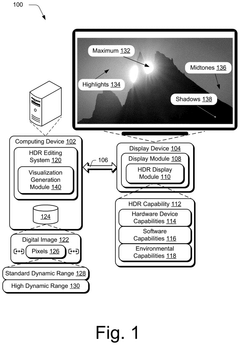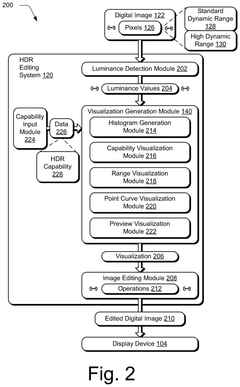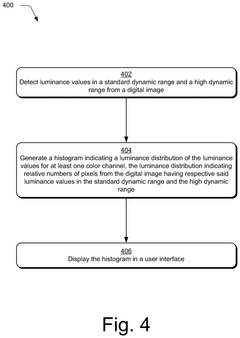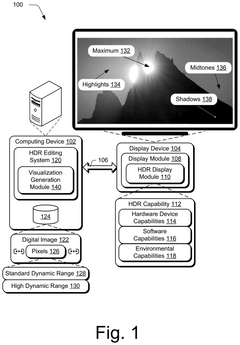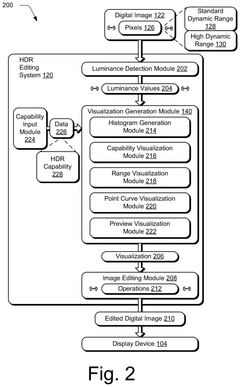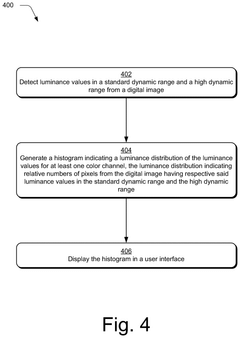Investigating Dolby Vision’s Potential in Architecture Visualization
JUL 30, 20259 MIN READ
Generate Your Research Report Instantly with AI Agent
Patsnap Eureka helps you evaluate technical feasibility & market potential.
Dolby Vision in Architecture: Background and Objectives
Dolby Vision, a cutting-edge High Dynamic Range (HDR) technology, has revolutionized the visual experience across various industries. In recent years, its potential application in architecture visualization has garnered significant attention. This technology, originally developed for cinema and home entertainment, offers unprecedented color depth, brightness, and contrast, which could dramatically enhance the way architectural designs are presented and experienced.
The evolution of Dolby Vision in the field of architecture visualization stems from the increasing demand for more immersive and realistic representations of architectural concepts. As the complexity and sophistication of architectural designs continue to grow, so does the need for advanced visualization tools that can accurately convey the nuances of these designs to clients, stakeholders, and the public.
The primary objective of investigating Dolby Vision's potential in architecture visualization is to explore how this technology can elevate the quality and impact of architectural renderings, walkthroughs, and presentations. By leveraging Dolby Vision's capabilities, architects and designers aim to create more lifelike and engaging visual experiences that better communicate their design intent and spatial concepts.
One of the key aspects of this investigation is to understand how Dolby Vision's enhanced color gamut and luminance range can be utilized to accurately represent materials, lighting conditions, and atmospheric effects in architectural visualizations. This includes exploring the technology's ability to showcase the interplay of natural and artificial light within designed spaces, as well as its capacity to render subtle textures and finishes with unprecedented fidelity.
Furthermore, the exploration of Dolby Vision in architecture visualization seeks to address the limitations of traditional display technologies in accurately representing the full range of colors and light intensities present in real-world environments. By doing so, it aims to bridge the gap between the architect's vision and the client's perception, potentially reducing misunderstandings and improving the overall design process.
Another crucial objective is to assess the practical implications of implementing Dolby Vision technology in architectural workflows. This includes evaluating the necessary hardware and software requirements, as well as the potential impact on rendering times and file sizes. Additionally, the investigation aims to determine the compatibility of Dolby Vision with existing architectural visualization tools and platforms, ensuring a seamless integration into current design processes.
As the architecture industry continues to embrace digital transformation, the adoption of advanced visualization technologies like Dolby Vision aligns with the broader trend of leveraging cutting-edge tools to enhance creativity, efficiency, and communication in the design process. This investigation into Dolby Vision's potential not only seeks to improve the visual quality of architectural presentations but also aims to explore new possibilities in how architectural spaces are conceived, designed, and experienced in the digital realm.
The evolution of Dolby Vision in the field of architecture visualization stems from the increasing demand for more immersive and realistic representations of architectural concepts. As the complexity and sophistication of architectural designs continue to grow, so does the need for advanced visualization tools that can accurately convey the nuances of these designs to clients, stakeholders, and the public.
The primary objective of investigating Dolby Vision's potential in architecture visualization is to explore how this technology can elevate the quality and impact of architectural renderings, walkthroughs, and presentations. By leveraging Dolby Vision's capabilities, architects and designers aim to create more lifelike and engaging visual experiences that better communicate their design intent and spatial concepts.
One of the key aspects of this investigation is to understand how Dolby Vision's enhanced color gamut and luminance range can be utilized to accurately represent materials, lighting conditions, and atmospheric effects in architectural visualizations. This includes exploring the technology's ability to showcase the interplay of natural and artificial light within designed spaces, as well as its capacity to render subtle textures and finishes with unprecedented fidelity.
Furthermore, the exploration of Dolby Vision in architecture visualization seeks to address the limitations of traditional display technologies in accurately representing the full range of colors and light intensities present in real-world environments. By doing so, it aims to bridge the gap between the architect's vision and the client's perception, potentially reducing misunderstandings and improving the overall design process.
Another crucial objective is to assess the practical implications of implementing Dolby Vision technology in architectural workflows. This includes evaluating the necessary hardware and software requirements, as well as the potential impact on rendering times and file sizes. Additionally, the investigation aims to determine the compatibility of Dolby Vision with existing architectural visualization tools and platforms, ensuring a seamless integration into current design processes.
As the architecture industry continues to embrace digital transformation, the adoption of advanced visualization technologies like Dolby Vision aligns with the broader trend of leveraging cutting-edge tools to enhance creativity, efficiency, and communication in the design process. This investigation into Dolby Vision's potential not only seeks to improve the visual quality of architectural presentations but also aims to explore new possibilities in how architectural spaces are conceived, designed, and experienced in the digital realm.
Market Demand Analysis for Advanced Visualization
The market demand for advanced visualization technologies in architecture has been steadily growing, driven by the increasing need for more immersive and realistic representations of architectural designs. Dolby Vision, known for its high dynamic range (HDR) capabilities in the entertainment industry, presents a promising opportunity to revolutionize architectural visualization.
The global architectural services market is projected to reach significant growth in the coming years, with a substantial portion attributed to visualization services. This growth is fueled by the rising complexity of architectural projects and the demand for more sophisticated presentation tools. Clients, investors, and stakeholders increasingly expect photorealistic renderings and immersive experiences to better understand and evaluate proposed designs.
Dolby Vision's potential in this market stems from its ability to deliver superior image quality with enhanced contrast, brightness, and color accuracy. These features are particularly valuable in architectural visualization, where accurate representation of materials, lighting, and spatial relationships is crucial. The technology's capacity to display a wider range of colors and luminance levels can significantly improve the realism of architectural renderings, allowing for more accurate depictions of both interior and exterior spaces under various lighting conditions.
The demand for Dolby Vision in architecture visualization is further driven by the growing adoption of virtual reality (VR) and augmented reality (AR) technologies in the industry. These immersive technologies benefit greatly from the enhanced visual fidelity that Dolby Vision provides, creating more engaging and convincing virtual walkthroughs of architectural designs.
Moreover, the increasing focus on sustainable and energy-efficient building designs has created a need for more accurate visualization of lighting scenarios and daylighting effects. Dolby Vision's advanced HDR capabilities can offer architects and designers a more precise tool for simulating and presenting these critical aspects of their designs.
The market also shows a trend towards cloud-based rendering services, which could potentially integrate Dolby Vision technology to offer high-quality visualization solutions to a broader range of architectural firms, including smaller practices that may not have access to high-end rendering hardware.
However, the adoption of Dolby Vision in architectural visualization faces some challenges. These include the need for specialized hardware and software support, potential licensing costs, and the requirement for training and expertise to fully utilize the technology's capabilities. Despite these challenges, the potential benefits in terms of improved design communication and client satisfaction suggest a growing market opportunity for Dolby Vision in the architectural visualization sector.
The global architectural services market is projected to reach significant growth in the coming years, with a substantial portion attributed to visualization services. This growth is fueled by the rising complexity of architectural projects and the demand for more sophisticated presentation tools. Clients, investors, and stakeholders increasingly expect photorealistic renderings and immersive experiences to better understand and evaluate proposed designs.
Dolby Vision's potential in this market stems from its ability to deliver superior image quality with enhanced contrast, brightness, and color accuracy. These features are particularly valuable in architectural visualization, where accurate representation of materials, lighting, and spatial relationships is crucial. The technology's capacity to display a wider range of colors and luminance levels can significantly improve the realism of architectural renderings, allowing for more accurate depictions of both interior and exterior spaces under various lighting conditions.
The demand for Dolby Vision in architecture visualization is further driven by the growing adoption of virtual reality (VR) and augmented reality (AR) technologies in the industry. These immersive technologies benefit greatly from the enhanced visual fidelity that Dolby Vision provides, creating more engaging and convincing virtual walkthroughs of architectural designs.
Moreover, the increasing focus on sustainable and energy-efficient building designs has created a need for more accurate visualization of lighting scenarios and daylighting effects. Dolby Vision's advanced HDR capabilities can offer architects and designers a more precise tool for simulating and presenting these critical aspects of their designs.
The market also shows a trend towards cloud-based rendering services, which could potentially integrate Dolby Vision technology to offer high-quality visualization solutions to a broader range of architectural firms, including smaller practices that may not have access to high-end rendering hardware.
However, the adoption of Dolby Vision in architectural visualization faces some challenges. These include the need for specialized hardware and software support, potential licensing costs, and the requirement for training and expertise to fully utilize the technology's capabilities. Despite these challenges, the potential benefits in terms of improved design communication and client satisfaction suggest a growing market opportunity for Dolby Vision in the architectural visualization sector.
Current Challenges in Architectural Visualization
Architectural visualization faces several significant challenges in the current landscape. One of the primary issues is the accurate representation of lighting and color, which is crucial for conveying the true essence of architectural designs. Traditional rendering techniques often struggle to capture the nuanced interplay of light and shadow, resulting in flat or unrealistic images that fail to engage clients or stakeholders effectively.
Another major challenge is the limitation of display technology. Many architectural firms and clients still rely on standard dynamic range (SDR) displays, which have restricted color gamuts and limited brightness ranges. This constraint makes it difficult to showcase the full spectrum of colors and lighting conditions that exist in real-world environments, potentially leading to misinterpretations of design intent or material choices.
The complexity of modern architectural designs also poses a significant hurdle for visualization. As buildings become more intricate and incorporate advanced sustainable features, traditional rendering methods may struggle to accurately depict these elements. This can result in a disconnect between the architect's vision and the final visualization, potentially impacting decision-making processes and client approval.
Furthermore, the time and computational resources required for high-quality architectural renderings present ongoing challenges. Producing photorealistic visualizations often demands substantial processing power and can be time-consuming, which can delay project timelines and increase costs. This is particularly problematic in fast-paced design environments where quick iterations and client feedback are essential.
The need for consistent color accuracy across different devices and viewing conditions is another persistent issue. Architectural visualizations may be viewed on various screens, from smartphones to large-format displays, each with its own color profile and capabilities. Ensuring that the intended colors and lighting effects are preserved across these diverse platforms remains a significant technical challenge.
Lastly, the integration of real-time visualization technologies, while promising, introduces new complexities. While real-time rendering offers the potential for interactive walkthroughs and on-the-fly design modifications, it often comes at the cost of reduced visual fidelity compared to pre-rendered images. Striking the right balance between interactivity and visual quality continues to be a key challenge in the field of architectural visualization.
Another major challenge is the limitation of display technology. Many architectural firms and clients still rely on standard dynamic range (SDR) displays, which have restricted color gamuts and limited brightness ranges. This constraint makes it difficult to showcase the full spectrum of colors and lighting conditions that exist in real-world environments, potentially leading to misinterpretations of design intent or material choices.
The complexity of modern architectural designs also poses a significant hurdle for visualization. As buildings become more intricate and incorporate advanced sustainable features, traditional rendering methods may struggle to accurately depict these elements. This can result in a disconnect between the architect's vision and the final visualization, potentially impacting decision-making processes and client approval.
Furthermore, the time and computational resources required for high-quality architectural renderings present ongoing challenges. Producing photorealistic visualizations often demands substantial processing power and can be time-consuming, which can delay project timelines and increase costs. This is particularly problematic in fast-paced design environments where quick iterations and client feedback are essential.
The need for consistent color accuracy across different devices and viewing conditions is another persistent issue. Architectural visualizations may be viewed on various screens, from smartphones to large-format displays, each with its own color profile and capabilities. Ensuring that the intended colors and lighting effects are preserved across these diverse platforms remains a significant technical challenge.
Lastly, the integration of real-time visualization technologies, while promising, introduces new complexities. While real-time rendering offers the potential for interactive walkthroughs and on-the-fly design modifications, it often comes at the cost of reduced visual fidelity compared to pre-rendered images. Striking the right balance between interactivity and visual quality continues to be a key challenge in the field of architectural visualization.
Existing Dolby Vision Implementation Solutions
01 High Dynamic Range (HDR) Technology
Dolby Vision utilizes HDR technology to enhance visual quality by expanding the range of both contrast and color. This results in brighter highlights, deeper blacks, and a wider color gamut, providing a more lifelike and immersive viewing experience.- High Dynamic Range (HDR) Technology: Dolby Vision utilizes HDR technology to enhance visual quality by expanding the range of both contrast and color. This results in brighter highlights, deeper blacks, and a wider color gamut, providing a more lifelike and immersive viewing experience.
- Dynamic Metadata Processing: Dolby Vision employs dynamic metadata processing to optimize the image on a scene-by-scene or even frame-by-frame basis. This allows for precise control over brightness, contrast, and color, ensuring that each frame is displayed at its best possible quality.
- Color Grading and Mapping: Advanced color grading and mapping techniques are used in Dolby Vision to ensure accurate color reproduction across different display devices. This includes support for wide color gamuts and precise color management to maintain the creator's intended visual quality.
- Display Calibration and Optimization: Dolby Vision incorporates display calibration and optimization technologies to ensure that content is displayed optimally on various screens. This includes adjusting for the specific capabilities of each display device, such as peak brightness and color volume.
- Content Creation and Mastering Tools: Dolby Vision provides content creators with specialized tools for mastering and grading content to take full advantage of the technology's capabilities. These tools enable precise control over the visual quality throughout the content creation process, ensuring the highest possible standards are maintained.
02 Dynamic Metadata Processing
Dolby Vision employs dynamic metadata processing to optimize the image on a frame-by-frame or scene-by-scene basis. This allows for precise control over brightness, color, and contrast, ensuring that each frame is displayed at its best possible quality.Expand Specific Solutions03 Color Grading and Mapping
Advanced color grading and mapping techniques are used in Dolby Vision to accurately reproduce colors across different display devices. This ensures consistent color representation and maintains the creator's artistic intent, regardless of the viewing device's capabilities.Expand Specific Solutions04 Display Device Optimization
Dolby Vision technology includes features to optimize content for specific display devices. This involves adjusting the content based on the display's capabilities, such as peak brightness, color gamut, and contrast ratio, to deliver the best possible image quality on each device.Expand Specific Solutions05 Content Creation and Mastering Tools
Dolby Vision provides content creators with specialized tools for mastering and grading content in high quality. These tools enable precise control over various visual parameters, allowing creators to achieve their desired visual aesthetic and ensure optimal playback across different devices.Expand Specific Solutions
Key Players in Dolby Vision and Architecture Software
The investigation of Dolby Vision's potential in architecture visualization is taking place in a rapidly evolving market. The industry is in a growth phase, with increasing demand for high-quality visual experiences in architectural design and presentation. The global market for architectural visualization is expanding, driven by advancements in technology and the need for more immersive and realistic representations. While Dolby Vision technology is relatively mature in the entertainment sector, its application in architecture is still emerging. Companies like Koninklijke Philips NV, HP Development Co. LP, and Microsoft Technology Licensing LLC are likely to play significant roles in adapting and implementing this technology for architectural purposes, leveraging their expertise in display technologies and software solutions.
Koninklijke Philips NV
Technical Solution: Philips has developed a Dolby Vision-compatible display technology specifically tailored for architecture visualization. Their solution focuses on creating ultra-high-definition displays that can accurately reproduce the expanded color and contrast range offered by Dolby Vision. The displays are calibrated to maintain color accuracy across different lighting conditions, which is crucial for architectural presentations[2]. Philips has also incorporated ambient light sensing technology that adjusts the display's output based on the surrounding environment, ensuring optimal visibility and color representation in various viewing scenarios[4]. Additionally, they have developed software tools that allow for easy integration of Dolby Vision content into existing architectural visualization workflows, streamlining the adoption process for design firms[6].
Strengths: High-quality display hardware optimized for Dolby Vision, adaptive ambient light technology, and user-friendly software integration. Weaknesses: Potentially higher costs compared to standard displays and limited compatibility with some existing visualization software.
HP Development Co. LP
Technical Solution: HP has created a comprehensive ecosystem for Dolby Vision in architecture visualization, encompassing both hardware and software solutions. Their approach includes high-performance workstations specifically optimized for rendering Dolby Vision content, featuring powerful GPUs and color-accurate displays[7]. HP's software suite includes plugins for popular 3D modeling and rendering applications, enabling seamless export of Dolby Vision-compatible content[9]. The company has also developed a cloud-based rendering service that allows architects to offload computationally intensive Dolby Vision rendering tasks, reducing local hardware requirements and enabling faster turnaround times for complex visualizations[11]. Furthermore, HP has partnered with several architecture firms to create case studies demonstrating the tangible benefits of Dolby Vision in client presentations and design reviews[13].
Strengths: End-to-end solution from hardware to software, cloud-based rendering capabilities, and established partnerships in the architecture industry. Weaknesses: Potential vendor lock-in and higher initial investment costs for full ecosystem adoption.
Core Innovations in Dolby Vision for Architecture
High dynamic range visualizations indicating ranges, point curves, and previews
PatentPendingUS20250117977A1
Innovation
- A high dynamic range editing system is configured to generate various visualizations, such as histograms, capability visualizations, range visualizations, point curves, and previews, to aid digital image editing and address the challenges of HDR across different devices and conditions.
High dynamic range digital image editing visualizations
PatentPendingUS20250117993A1
Innovation
- A high dynamic range editing system is developed to generate visualizations that aid in digital image editing, including histograms, capability visualizations, range visualizations, point curves, and previews, to address the challenges of HDR editing across varying display devices and conditions.
Hardware Requirements and Compatibility
Implementing Dolby Vision in architecture visualization requires specific hardware configurations to ensure optimal performance and compatibility. The primary hardware components that need consideration are displays, graphics cards, and processing units.
Displays play a crucial role in showcasing Dolby Vision content. For architecture visualization, high-end monitors or TVs that support Dolby Vision HDR are essential. These displays should have a minimum resolution of 4K (3840x2160 pixels) and be capable of handling the wide color gamut and high dynamic range that Dolby Vision offers. OLED and QLED technologies are particularly well-suited for this purpose due to their superior contrast ratios and color accuracy.
Graphics cards are another critical component in the Dolby Vision pipeline. To handle the increased computational demands of Dolby Vision content, a powerful GPU is necessary. NVIDIA's RTX series or AMD's Radeon RX series, particularly models from the last two generations, are recommended. These GPUs should have dedicated hardware for real-time ray tracing and AI-enhanced upscaling, which can significantly improve the quality and performance of architecture visualizations.
Processing power is equally important, as rendering Dolby Vision content requires substantial computational resources. High-performance CPUs, such as Intel's Core i7/i9 or AMD's Ryzen 7/9 series, are recommended to ensure smooth operation and quick rendering times. For professional setups, workstation-grade processors like Intel Xeon or AMD Threadripper may be necessary, especially when dealing with complex architectural models and high-resolution textures.
Storage considerations are also crucial. Fast SSDs, preferably NVMe drives, are essential for quick data access and smooth playback of high-bitrate Dolby Vision content. A minimum of 1TB storage is recommended, with larger capacities needed for extensive project libraries.
Compatibility extends beyond hardware to software as well. The visualization software used must support Dolby Vision output. Popular architecture visualization tools like Autodesk 3ds Max, V-Ray, and Unreal Engine have begun incorporating HDR rendering capabilities, but specific Dolby Vision integration may require additional plugins or updates.
Networking infrastructure should also be considered, especially in collaborative environments. High-speed, low-latency networks are crucial for sharing and reviewing large Dolby Vision files. 10 Gigabit Ethernet or faster connections may be necessary in professional settings.
Lastly, calibration tools are essential for ensuring accurate color reproduction across different displays and workstations. Hardware calibration devices and software that support Dolby Vision profiles are crucial for maintaining consistency in the visualization pipeline.
Displays play a crucial role in showcasing Dolby Vision content. For architecture visualization, high-end monitors or TVs that support Dolby Vision HDR are essential. These displays should have a minimum resolution of 4K (3840x2160 pixels) and be capable of handling the wide color gamut and high dynamic range that Dolby Vision offers. OLED and QLED technologies are particularly well-suited for this purpose due to their superior contrast ratios and color accuracy.
Graphics cards are another critical component in the Dolby Vision pipeline. To handle the increased computational demands of Dolby Vision content, a powerful GPU is necessary. NVIDIA's RTX series or AMD's Radeon RX series, particularly models from the last two generations, are recommended. These GPUs should have dedicated hardware for real-time ray tracing and AI-enhanced upscaling, which can significantly improve the quality and performance of architecture visualizations.
Processing power is equally important, as rendering Dolby Vision content requires substantial computational resources. High-performance CPUs, such as Intel's Core i7/i9 or AMD's Ryzen 7/9 series, are recommended to ensure smooth operation and quick rendering times. For professional setups, workstation-grade processors like Intel Xeon or AMD Threadripper may be necessary, especially when dealing with complex architectural models and high-resolution textures.
Storage considerations are also crucial. Fast SSDs, preferably NVMe drives, are essential for quick data access and smooth playback of high-bitrate Dolby Vision content. A minimum of 1TB storage is recommended, with larger capacities needed for extensive project libraries.
Compatibility extends beyond hardware to software as well. The visualization software used must support Dolby Vision output. Popular architecture visualization tools like Autodesk 3ds Max, V-Ray, and Unreal Engine have begun incorporating HDR rendering capabilities, but specific Dolby Vision integration may require additional plugins or updates.
Networking infrastructure should also be considered, especially in collaborative environments. High-speed, low-latency networks are crucial for sharing and reviewing large Dolby Vision files. 10 Gigabit Ethernet or faster connections may be necessary in professional settings.
Lastly, calibration tools are essential for ensuring accurate color reproduction across different displays and workstations. Hardware calibration devices and software that support Dolby Vision profiles are crucial for maintaining consistency in the visualization pipeline.
Cost-Benefit Analysis for Architectural Firms
Implementing Dolby Vision technology in architectural visualization requires a thorough cost-benefit analysis for architectural firms. The initial investment in hardware and software upgrades can be substantial, including high-end displays, color-accurate monitors, and specialized rendering tools. However, these costs should be weighed against the potential long-term benefits and competitive advantages.
One of the primary benefits is the enhanced visual quality and accuracy of architectural renderings. Dolby Vision's high dynamic range (HDR) and wide color gamut capabilities allow for more realistic representation of lighting, materials, and textures. This can lead to improved client satisfaction and better decision-making during the design process, potentially reducing costly revisions and changes later in the project lifecycle.
The technology also offers a competitive edge in the market. Architectural firms that can showcase designs with superior visual fidelity may attract high-profile clients and projects, potentially justifying premium pricing for their services. This could result in increased revenue and market share over time.
However, firms must consider the learning curve and training costs associated with implementing new technology. Staff may require time to adapt to new workflows and software, which could temporarily impact productivity. Additionally, there may be ongoing costs for software licenses, updates, and maintenance of specialized equipment.
Another factor to consider is the compatibility with existing systems and client requirements. While Dolby Vision can provide superior results, not all clients may have the capability to view these enhanced visualizations, potentially limiting the immediate value of the investment.
In terms of workflow efficiency, Dolby Vision could streamline certain processes by providing more accurate representations earlier in the design phase. This could lead to faster approvals and reduced time spent on iterative adjustments, ultimately saving time and resources.
The return on investment (ROI) timeline is an important consideration. While the initial costs may be high, the long-term benefits in terms of improved project outcomes, client satisfaction, and market positioning could provide significant returns over several years. Firms should conduct a detailed financial analysis, considering factors such as projected increase in project win rates, potential for higher-value contracts, and efficiency gains in the design process.
One of the primary benefits is the enhanced visual quality and accuracy of architectural renderings. Dolby Vision's high dynamic range (HDR) and wide color gamut capabilities allow for more realistic representation of lighting, materials, and textures. This can lead to improved client satisfaction and better decision-making during the design process, potentially reducing costly revisions and changes later in the project lifecycle.
The technology also offers a competitive edge in the market. Architectural firms that can showcase designs with superior visual fidelity may attract high-profile clients and projects, potentially justifying premium pricing for their services. This could result in increased revenue and market share over time.
However, firms must consider the learning curve and training costs associated with implementing new technology. Staff may require time to adapt to new workflows and software, which could temporarily impact productivity. Additionally, there may be ongoing costs for software licenses, updates, and maintenance of specialized equipment.
Another factor to consider is the compatibility with existing systems and client requirements. While Dolby Vision can provide superior results, not all clients may have the capability to view these enhanced visualizations, potentially limiting the immediate value of the investment.
In terms of workflow efficiency, Dolby Vision could streamline certain processes by providing more accurate representations earlier in the design phase. This could lead to faster approvals and reduced time spent on iterative adjustments, ultimately saving time and resources.
The return on investment (ROI) timeline is an important consideration. While the initial costs may be high, the long-term benefits in terms of improved project outcomes, client satisfaction, and market positioning could provide significant returns over several years. Firms should conduct a detailed financial analysis, considering factors such as projected increase in project win rates, potential for higher-value contracts, and efficiency gains in the design process.
Unlock deeper insights with Patsnap Eureka Quick Research — get a full tech report to explore trends and direct your research. Try now!
Generate Your Research Report Instantly with AI Agent
Supercharge your innovation with Patsnap Eureka AI Agent Platform!
